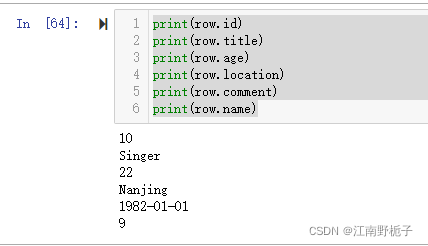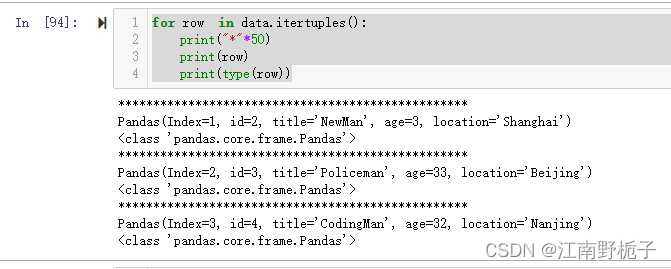目录
3.2 按行遍历 DataFrame.itertuples()
3.2.1 DataFrame.itertuples() 语法
3.2.2 DataFrame.itertuples() 范例
3.3 按列遍历 DataFrame.iteritems()
3.3.1 DataFrame.iteritems() 语法
3.3.2 DataFrame.iteritems() 范例
对于 pandas.DataFrame 有以下三种遍历方法
- iterrows(): 按行遍历,将 DataFrame 的每一行迭代为 (index, data) 对,可以通过data[column_name] 和 data.column_name 对元素进行访问。
- itertuples(): 按行遍历,将 DataFrame 的每一行迭代为元祖,可以通过data[ 列号数值 ] 和 data.column_name 对元素进行访问,不能使用 row[ column_name ]对元素进行访问,比 iterrows() 效率高。
- iteritems():按列遍历,将 DataFrame 的每一列迭代为(label, content)对,可以通过content[ index ] 对元素进行访问。
3. DataFrame 类型的遍历过程
先准备数据
import pandas as pd
import numpy as np
import pymysql
conn=pymysql.connect(host="127.0.0.1",user="root",password="wxf123",database="ivydb")
data=pd.read_sql('''SELECT * FROM human;''', con = conn)
data生成数据如下

3.1 按行遍历 DataFrame.iterrows()
3.1.1 DataFrame.iterrows() 语法
首先,DataFrame.iterrows() 函数没有参数
其次,DataFrame.iterrows() 返回 Iterable 的 [index,data] 对,可以理解 index 即行名,data 即此行的数据,为 Series 类型。既然是 Iterable 类型的,意味着可以用 next 来逐步读取。
再次,对于读出来的 data,可以通过 data[column_name] 读取具体的某个元素
最后,请注意应该**永远不要修改**您正在迭代的内容。这并不能保证在所有情况下都有效。取决于数据类型,迭代器返回的是一个副本而不是一个视图,如果你视图写入,这样做是没有效果的。
简单说,我建议在所有迭代过程中,都不要有写入过程。
Help on method iterrows in module pandas.core.frame:
iterrows() -> 'Iterable[Tuple[Label, Series]]' method of pandas.core.frame.DataFrame instance
Iterate over DataFrame rows as (index, Series) pairs.
Yields
------
index : label or tuple of label
The index of the row. A tuple for a `MultiIndex`.
data : Series
The data of the row as a Series.
See Also
--------
DataFrame.itertuples : Iterate over DataFrame rows as namedtuples of the values.
DataFrame.items : Iterate over (column name, Series) pairs.
Notes
-----
1. Because ``iterrows`` returns a Series for each row,
it does **not** preserve dtypes across the rows (dtypes are
preserved across columns for DataFrames). For example,
>>> df = pd.DataFrame([[1, 1.5]], columns=['int', 'float'])
>>> row = next(df.iterrows())[1]
>>> row
int 1.0
float 1.5
Name: 0, dtype: float64
>>> print(row['int'].dtype)
float64
>>> print(df['int'].dtype)
int64
To preserve dtypes while iterating over the rows, it is better
to use :meth:`itertuples` which returns namedtuples of the values
and which is generally faster than ``iterrows``.
2. You should **never modify** something you are iterating over.
This is not guaranteed to work in all cases. Depending on the
data types, the iterator returns a copy and not a view, and writing
to it will have no effect.
3.1.2 DataFrame.iterrows() 范例
代码范例,此处使用大家最熟悉的 for 循环
for rowname,row in data.iterrows():
print("*"*50)
print(rowname)
print(type(row))
print(row)结果如下,可以看到不同的行名和行数据,
************************************************** 0 <class 'pandas.core.series.Series'> id 1 title Teacher age 36 location Beijing comment 1982-01-01 Name: 0, dtype: object ************************************************** 1 <class 'pandas.core.series.Series'> id 2 title NewMan age 3 location Shanghai comment 1983-02-01 Name: 1, dtype: object ************************************************** 2 <class 'pandas.core.series.Series'> id 3 title Policeman age 33 location Beijing comment 1984-05-09 Name: 2, dtype: object ...................................................... 9 <class 'pandas.core.series.Series'> id 10 title Singer age 22 location Nanjing comment 1982-01-01 Name: 9, dtype: object
如果想对某个元素来进行读取,有两种方式,第一种是 row.column_name
print(row.id)
print(row.title)
print(row.age)
print(row.location)
print(row.comment)
print(row.name)运行结果如下

第二种方式是 row[column_name] 方式
print(row["id"])
print(row["title"])
print(row["age"])
print(row["location"])
print(row["comment"])
# print(row["name"]) 不能用这个方式读 row 的名字,只能用 row. name 方式运行结果如下

3.2 按行遍历 DataFrame.itertuples()
itertuples() 也是按照行来进行迭代,和 iterrows() 一样将返回一个迭代器,该方法会把 DataFrame 的每一行生成一个元组,最关键的是比 iterrows() 效率高。。
3.2.1 DataFrame.itertuples() 语法
itertuples(index: 'bool' = True, name: 'Optional[str]' = 'Pandas')
首先,和 iterrows() 不一样,itertuples() 有两个参数。
index: 布尔值,默认为 True,即返回的每行数据里面是否包含 index,如果为 False,则不包含
name:字符串或者为 None,默认为 "Pandas",是返回的namedtuples的名字,如果为None,则名字也为空。
其次,.itertuples() 返回的是 默认是'pandas.core.frame.Pandas',是元组类型
Help on method itertuples in module pandas.core.frame:
itertuples(index: 'bool' = True, name: 'Optional[str]' = 'Pandas') method of pandas.core.frame.DataFrame instance
Iterate over DataFrame rows as namedtuples.
Parameters
----------
index : bool, default True
If True, return the index as the first element of the tuple.
name : str or None, default "Pandas"
The name of the returned namedtuples or None to return regular
tuples.
Returns
-------
iterator
An object to iterate over namedtuples for each row in the
DataFrame with the first field possibly being the index and
following fields being the column values.
See Also
--------
DataFrame.iterrows : Iterate over DataFrame rows as (index, Series)
pairs.
DataFrame.items : Iterate over (column name, Series) pairs.
Notes
-----
The column names will be renamed to positional names if they are
invalid Python identifiers, repeated, or start with an underscore.
On python versions < 3.7 regular tuples are returned for DataFrames
with a large number of columns (>254).
Examples
--------
>>> df = pd.DataFrame({'num_legs': [4, 2], 'num_wings': [0, 2]},
... index=['dog', 'hawk'])
>>> df
num_legs num_wings
dog 4 0
hawk 2 2
>>> for row in df.itertuples():
... print(row)
...
Pandas(Index='dog', num_legs=4, num_wings=0)
Pandas(Index='hawk', num_legs=2, num_wings=2)
By setting the `index` parameter to False we can remove the index
as the first element of the tuple:
>>> for row in df.itertuples(index=False):
... print(row)
...
Pandas(num_legs=4, num_wings=0)
Pandas(num_legs=2, num_wings=2)
With the `name` parameter set we set a custom name for the yielded
namedtuples:
>>> for row in df.itertuples(name='Animal'):
... print(row)
...
Animal(Index='dog', num_legs=4, num_wings=0)
Animal(Index='hawk', num_legs=2, num_wings=2)
3.2.2 DataFrame.itertuples() 范例
现在我简化一下数据,这样可以看得更加清楚点

1) index 和 name 都为 默认的情况
for row in data.itertuples():
print("*"*50)
print(row)
print(type(row))运行结果如下,可以看得结果中包含了 index,type 出来的类型名为 'pandas.core.frame.Pandas'

如果想读取具体的元素,如下
print(row.id)
print(row.title)
print(row.age)
print(row.location)
#print(row.name) 此时不可读 row 的名字
print(row.index)
print(row.Index)运行结果

此外,因为.itertuples() 返回的是 tuple 类型,所以不能使用 row[column_name]的方式读取

可以使用使用 row[column_no]的方式读取
print(row[0:3])运行结果

2) 如果 index= False,name="NewPandas"
for row in data.itertuples(index=False,name="NewPandas"):
print("*"*50)
print(row)
print(type(row))运行结果如下:
可以看得结果中不再包含了 index,type 出来的类型名为 'pandas.core.frame.NewPandas'

3.3 按列遍历 DataFrame.iteritems()
DataFrame.iteritems()
3.3.1 DataFrame.iteritems() 语法
首先,.iteritems() 没有参数
其次,.iteritems() 生成[label,content] 数据对,对于具体的元素,可以通过 content[index] 和content.index 来读取
最后,
Help on method iteritems in module pandas.core.frame:
iteritems() -> 'Iterable[Tuple[Label, Series]]' method of pandas.core.frame.DataFrame instance
Iterate over (column name, Series) pairs.
Iterates over the DataFrame columns, returning a tuple with
the column name and the content as a Series.
Yields
------
label : object
The column names for the DataFrame being iterated over.
content : Series
The column entries belonging to each label, as a Series.
See Also
--------
DataFrame.iterrows : Iterate over DataFrame rows as
(index, Series) pairs.
DataFrame.itertuples : Iterate over DataFrame rows as namedtuples
of the values.
Examples
--------
>>> df = pd.DataFrame({'species': ['bear', 'bear', 'marsupial'],
... 'population': [1864, 22000, 80000]},
... index=['panda', 'polar', 'koala'])
>>> df
species population
panda bear 1864
polar bear 22000
koala marsupial 80000
>>> for label, content in df.items():
... print(f'label: {label}')
... print(f'content: {content}', sep='\n')
...
label: species
content:
panda bear
polar bear
koala marsupial
Name: species, dtype: object
label: population
content:
panda 1864
polar 22000
koala 80000
Name: population, dtype: int64
3.3.2 DataFrame.iteritems() 范例
代码范例,此处使用大家最熟悉的 for 循环
for columnname,column in data.iteritems():
print("*"*50)
print(columnname)
print(type(columnname))
print(column)
print(type(column))结果如下,可以看到不同的列名和列数据,
************************************************** id <class 'str'> 1 2 2 3 3 4 Name: id, dtype: int64 <class 'pandas.core.series.Series'> ************************************************** title <class 'str'> 1 NewMan 2 Policeman 3 CodingMan Name: title, dtype: object <class 'pandas.core.series.Series'> ************************************************** age <class 'str'> 1 3 2 33 3 32 Name: age, dtype: int64 <class 'pandas.core.series.Series'> ************************************************** location <class 'str'> 1 Shanghai 2 Beijing 3 Nanjing Name: location, dtype: object <class 'pandas.core.series.Series'>
因为返回的 content (即代码中的 column) 是 series 类型,所以相关的读取可以参看 Series。























 1020
1020











 被折叠的 条评论
为什么被折叠?
被折叠的 条评论
为什么被折叠?










